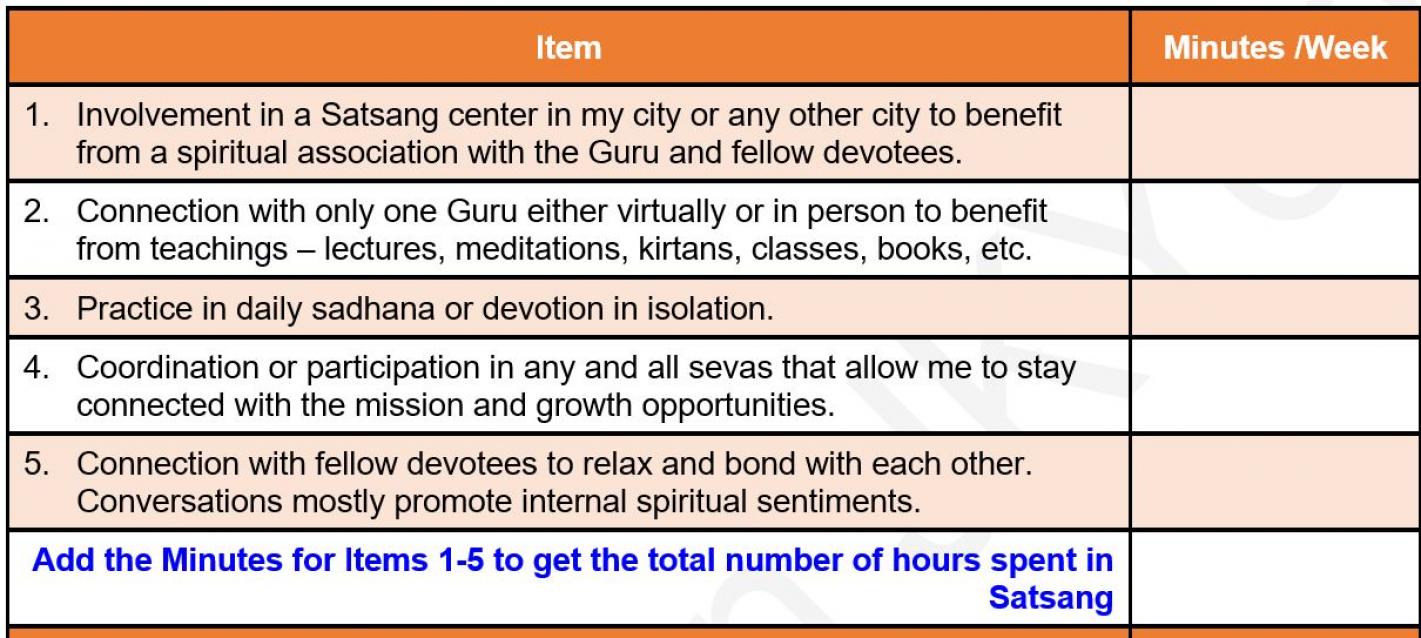
From the Editor’s Desk
Are you inspired to attain the ultimate goal of God-realization? If yes, the first step is to associate with a true Guru through Satsang. An association with a God-realized saint has the power to enable material souls to gain divine knowledge, develop faith, and also free them from sins of endless lifetimes. Let us understand the power of Satsang through the Vedic scriptures (i.e., tatvagyan) as taught by Swami Mukundananda.

Vedic Wisdom & Application
Challenge of the Month
Power of Satsang
Reflection Questions
- What is Satsang? What is the Purpose of Satsang?
- How does Satsang Transform People?
- How can People be Involved in Satsang?
Human beings are blessed with the faculty of knowledge and an innate desire to seek divine knowledge. However, the instruments for processing such knowledge are material, leading to defects like: (1) over-reliance on the five senses of perception; (2) illusion regarding the permanence of temporary objects (e.g., the body), and belief that sensory objects are sources of pleasure; (3) predisposition to making advertent and inadvertent mistakes; and (4) propensity to hide one’s own faults and extol non-existent virtues. Thus, if human beings seek scriptural knowledge through defective tools, there will be little scope to develop wisdom. Thus, we must rely on two perfect sources – the Vedic scriptures and God-realized saints to learn divine knowledge and practice its application for life transformation.
While we may have easy access to Vedic scriptures, we need to associate with a God-realized saint for an accurate interpretation of the scriptures and to learn the practice of devotion. An association with a God-realized saint has the power to enable material souls to gain divine knowledge, develop faith, and also free them from sins of endless lifetimes. This is possible only through Satsang with a true Guru.
What is Satsang? What is the Purpose of Satsang?
The word Satsang literally means to associate (Sang) with the Truth (Satya). It can be in any form – reading holy scriptures, chanting the names of God, singing kirtans, meditating on God’s divine qualities, listening to the words of saints, and/or contemplating on the ways to close the gap between spiritual goals and our current practice. Satsang is characterized by a congregation of devotees who engage in holy communion that helps to attach the mind anywhere in the Divine realm.
Satsang is not just a collection of physical bodies going through a spiritual drill. It is the collective effort to free the mind from worldly distractions and focus the intellect on the names, virtues, pastimes, abodes and saints of God. It used to be that Satsangs were mostly in the physical presence of a God-realized saint, however, in the modern era, congregations take advantage of technological tools to associate with a Divine Guru through pre-recorded sermons, guided meditations, kirtans and virtual meetings.
It is well known that Jagadguru Shree Kripalu ji Maharaj initiated the Kirtan movement in the 1940-50s. Shree Maharajji’s Satsangs revolutionized the concept of Bhakti or devotion in the states of Utter Pradesh and Rajasthan. His kirtans were infused with intense devotion, often continuing throughout the night. Shree Maharajji wrote and composed many of the divine kirtans Himself, capturing the hearts of sincere devotees across the world. Spiritual scholars have compared Shree Maharajji’s kirtans to those of saints like Meerabai, Soordas, Tulsidas, and Ras Khan.
The purpose of Satsang is to deliberately absorb the mind in devotional activities. The materially conditioned mind is naturally drawn to worldly matters and objects without any effort. However, focusing the mind on God requires effort. Spiritual aspirants (or sadhaks) may find it easier to attach the mind to God when in a group with other like-minded devotees. They inspire each other, frequently discuss spiritual concepts to clarify doubts, and make an attempt to internally connect with God and Guru through conviction of the intellect.
How does Satsang Transform People?
It is divine grace that leads a soul to a spiritual master or Guru, and to Satsang with like-minded devotees. Consistent participation in Satsang then transforms the soul through control over the senses of perception and internal contemplation.
- Absorption of the Senses of Perception (i.e., Gyanindriyas). Spiritual aspirants may find it challenging to attach the mind in the divine realm during the initial stages of devotional practice. Thus, when they attend Satsang in temples, the sense of sight is captivated by the enticing form of the deities; the sense of hearing absorbs the divine words in discourses, meditation and kirtans; the sense of smell is captured by the fragrance of incense sticks and flowers; the sense of touch is enthralled by contact with the divine feet of the Guru or bowing down to the deities; and the sense of taste is nourished by the holy prasad (i.e., sacred offerings). Collectively, these gyanindriyas enable the mind to focus on God and Guru which increases devotion.
- Increased Attachment to the Divine and Detachment from Worldly Objects. Continued participation in Satsangs allows souls to associate with saints, develop a strong belief in their divine words (i.e, Vaani), and contemplate on the imparted knowledge. The words of the Guru increase the desire to apply the knowledge and grow from within. The teachings of the scriptures satisfy the soul. Internal contemplation on the divine knowledge and how to become a profitable and humble servant of God, helps to deepen the faith and love for God and Guru. Concurrently with increased attachment to the divine realm, the soul develops detachment from the mundane things in the material world.
-
Thoughts Shift from Negative to Positive. Satsang is an excellent way to learn to convert negative thoughts into positive affirmations. Lord Krishna cautioned Arjun about the dangers of dysfunctional thought patterns under the sway of the ego:
अनेकचित्तविभ्रान्ता मोहजालसमावृता: |
प्रसक्ता: कामभोगेषु पतन्ति नरकेऽशुचौ || 16||aneka-chitta-vibhrāntā moha-jāla-samāvṛitāḥ
prasaktāḥ kāma-bhogeṣhu patanti narake ’śhuchauPossessed and led astray by such imaginings, enveloped in a mesh of delusion, and addicted to the gratification of sensuous pleasures, they descend to the murkiest hell (Bhagavad Gita 16.16).
Poor quality thoughts obscure one’s own destiny but through the influence of Satsang with the Guru, sadhaks check their state of mind more frequently and try to replace harmful with positive thoughts that elevate our soul. The Guru teaches sadhaks learn the austerities of the mind to elevate consciousness.
मन: प्रसाद: सौम्यत्वं मौनमात्मविनिग्रह: |
भावसंशुद्धिरित्येतत्तपो मानसमुच्यते || 16||manaḥ-prasādaḥ saumyatvaṁ maunam ātma-vinigrahaḥ
bhāva-sanśhuddhir ity etat tapo mānasam uchyateSerenity of thought, gentleness, silence, self-control, and purity of purpose—all these are declared as austerity of the mind (Bhagavad Gita 17.16).
As Swamiji explains, “Each thought we dwell upon has consequences, and thought-by-thought, we forge our destiny. For this reason, to veer the mind from negative emotions and make it dwell upon the positive sentiments is considered an austerity of the mind.”
- Purification of the Etheric Heart. All material souls have five defects: (i) Asmita or false pride; (ii) Abhinivesh or fear of death; (iii) Raag or attachment to material things; (iv) Dvesh or hatred; and (v) Avidya or ignorance. As association with a true Guru increases through the power of Satsang, the defects and impurities gradually start to decrease. This deepens the faith and the intellect desires to practice devotion. Spiritual aspirants begin to seek opportunities to serve God and Guru, and seva becomes an expression of their love. The spiritual hunger arises from within, which in turn is reciprocated by divine grace in the form of brief moments of devotional bliss. This bliss is so satisfying to the soul that it becomes even more detached to worldly things. This process purifies the heart and gradually prepares it to receive the ultimate grace of God.
How can People be Involved in Satsang?
There are many ways to be involved in JKYog Satsangs.
- Find a JKYog Satsang center in your city or one closest to it. Know the schedule for Satsangs which may vary depending upon the size of the congregation. While a vast majority of the JKYog centers are in the US and India, devotees can join any Satsang center of their choice either in person or virtually.
- Associate with Swami Mukundananda. There are numerous ways to make a personal connection with Swamiji when He visits your city or state. The Life Transformational programs are held at numerous Satsang centers in US and similar programs in India. Devotees worldwide can also directly connect with Swamiji virtually through Swami Mukundananda Exclusive (SMEx), a membership-based portal. Other alternatives include attending retreats (US) and shivirs (India) to engage in intense sadhan bhakti under Swamiji’s direct guidance. In each of these events, Swamiji delivers focused discourses, conducts guided meditation or roop-dhyan, responds to questions from devotees, and provides guidance as needed.
- Practice Daily Sadhana in Isolation. Even if devotees participate in Satsangs on a consistent basis, it is important to take some time out every day for practicing sadhana or devotion in isolation. It could be in any form – listening to divine lectures, meditation, chanting kirtans, etc. The point is to connect with the true knowledge to keep it on surface and be able to draw upon it when needed.
-
Avoid Kusang or Bad Associations. While it is very important to participate in Satsang, it is even more crucial to avoid kusang. Kusang is the opposite of Satsang because it takes our mind away from God and Guru to worldly matters, which are very harmful for spiritual progress. In spiritual parlance, such associations are called kusang. Swamiji beautifully explains that it takes a lot of time to build our internal spiritual assets, but very little time to lose all the gains. This is because the material mind experiences immense pleasure from kusang, and the intellect is not disciplined enough to end such associations before it is too late. Examples include:
- Watching unnecessary movies or TV shows that pollute the mind, reading features in newspapers or magazines that cause distress, surfing the Internet for frivolous things, and engaging in social media that increases hypocrisy and destroys spiritual sentiments.
- Hanging out with people whose association increases mental afflictions like anger, lust, greed, etc., and fills the mind with doubts about God and Guru.
- Fault-finding because it gives rise to one’s pride and eliminates humility, which is the hallmark of spiritual growth. Even in Satsang groups, if we focus on faults of others, we will not benefit from positive associations. See the October 2020 issue of Samarpan which focuses on how to avoid fault-finding.
- Discussing deep scriptural knowledge with non-devotees or those who are not spiritually inclined. They are more likely to misinterpret scriptural knowledge, raise doubts, and taint the spiritual aspirant’s mind.
- False belief in one’s immunity to the effect of kusang. Many devotees become over-confident in their ability to attach the mind to God and believe that their intellect possesses the ability to resist the adverse effects of kusang. However, it is important to keep in mind that until God-realization, all souls are under the influence of Maya and not powered to beat it without divine grace. Even Ajamil, who was well-versed in the knowledge of the scriptures, was negatively influenced by watching one moment of kusang, resulting in a life filled with sin until divine intervention took place and helped him to return to Satsang.
All these forms of kusang tend to disturb the mind and lead to repeated contemplation in the wrong direction. If we are not careful, each of these has the potential to rob us of our spiritual earnings before we realize it.

Tools for Your Personal Growth
How much time do you invest in Satsang? According to Shree Maharajji, anything that does not constitute Satsang is kusang. Use this tool to assess yourself. A downloadable tracking sheet available for you to use.

This self-assessment tool is meant to provide an objective perspective on the amount of time spent in Satsang vs. kusang per week for your own realization and reflection.

Love to Hear from You
- How did you apply the Vedic Wisdom?
- What challenges did you experience in the process?
Please share your comments under “Join the Discussion” below.

Gems of Wisdom from Swamiji
Here are some YouTube video titles where Swamiji describes ways to progress on the path of devotion including engagement in Satsang and staying away from kusang.



Hold Your Breath! Check out Upcoming Events
We are very excited to share with you, three dynamite events this month!

The Power of Thoughts Book Launch
Swamiji’s much-awaited, brand new book, “The Power of Thoughts” will soon be published by Penguin Random House India Pvt Ltd. Swamiji will officially release his book on June 12, 2022 at the Radha Krishna Temple of Dallas, JKYog’s official Headquarters. Here are a few memorable quotes as a preview:
- Devotional sentiments are exceedingly powerful and can vanquish negative ones, like the light vanquishes darkness.
- Like the taut string allowing the kite to fly high, discipline enables us to do what we want in life because it liberates us from the slavery of our mind.
- Quiet space provides us an opportunity to introspect and evaluate where we are in our journey versus where we wish to be. We can think about our priorities. Then, if necessary, we can reinvent ourselves and shift our priorities, before moving ahead.
You can pre-order the book from Amazon now at a discounted rate!

JKYog International Yoga Festival 2022
The word “Yog” means union with God. Each year, JKYog hosts an International Festival of Yoga to celebrate all aspects of this ancient science. This year too, there will be a week-long schedule of activities for in-person and virtual attendees from June 15-21, 2022. The theme for this year is Yoga for Humanity. It was announced by India’s Prime Minister, Narendra Modi, in his monthly address to the nation. This theme was selected in acknowledgement of the role of yoga in alleviating the suffering of people during COVID-19. Additionally, Modi stated that “Yoga would bring people together through kindness and compassion during the post-COVID geopolitical crisis and foster a sense of unity across the world.” Program Highlights:
- Over 100 hours of free sessions on yoga, meditation, pranayam, alternative medicine, holistic medicine, and Patanjali Yoga Sutras.
- Enlightening discourses by globally renowned experts such as Swami Mukundananda, Swami Sarvapriyananda, Pujya Rameshbhai Oza (Bhaishri), Swami Chidananda Saraswati, Smita Sundararaman, Dr. Jagannath Dixit, Dr. Indranil Basu-Ray, Dr. Nick Shroff, and Suren Shrestha.
- FREE Health Fair for local participants featuring medical experts in internal medicine, cardiology, and oncology. Free consultation, EKG, blood work for Hga1c as needed for diabetic patients, and a bone marrow drive.
- Family Fun Time for local participants including art/craft activities, carnival games, Father’s Day celebration, games designed to improve focus and concentration of children and youth, and special games and prizes.
- One of the most notable features of JKYog’s Yoga Festival is the Wellness Expo and Marketplace featuring an exciting array of vendors who showcase and sell a variety of products associated with overall health, wellness and healing.

Spiritual Retreat and Family Camp 2022
The soul’s eternal relationship is with God alone. He is an ocean of bliss and when souls contemplate on Him, God enhances the bliss to the extent of devotion in their heart. He has been waiting for us with open arms to embrace us. So, how do we establish the relationship? By engaging in sadhana with Swamiji for an entire week.
Swamiji’s lecture series are filled with inspiration and divine knowledge. Participants can soak in the bliss of the esoteric and exceedingly sweet Gopi Geet to understand the notion of selfless love for God as well as the teachings of Lord Krishna to Arjun in the sacred Bhagavad Gita (Chapter 6). There are so many interpretations of the deep knowledge on both themes, making it essential to hear and understand it from a true source.
Other highlights include:
- Rath Yatra of Shree Radha-Krishna and Jagadguru Shree Kripalu ji Maharaj
- Picnic and Parikrama with Swamiji and Fellow Devotees
- Thought-provoking Q/A sessions with Swamiji
- Soulful bhajans spread throughout the day
- Interactive activities for the entire family
- JKY Idol Contest
- Parallel sessions for children and youth
Watch this beautiful video to catch a glimpse of the blissful times at the Family Camp. Register for the Family Camp to fill your heart with the bliss that the soul is seeking.
When: June 24th – June 30th
Where: Radha Krishna Temple, Allen, TX, or virtually via Zoom (for some events)
Details: https://www.radhakrishnatemple.net/spiritual-retreat-family-camp

Voices from the Global Community
In this feature, we introduce you to members of our global community who have been impacted by the scriptural knowledge as taught and disseminated by Swamiji through a written or video testimony. Two devotees, Kiran Bhat and Pooja Parikh, describe how their participation in Satsang helped them to grow in spiritual devotion as influenced by Swamiji’s teachings.


We invite you to share your inspirations and success stories with us at [email protected].

JKYog Transforming Communities
Here, we share the amazing activities and news about programs conducted by various JKYog centers in the U.S.
Update on Walk for Education and Healthcare

The Walk for Education and Healthcare was initiated to establish a world-class university and a hospital in a rural region of Odisha, India. The event was kicked off by Swamiji on April 24, 2022, at the Radha Krishna Temple of Dallas, the official headquarters of JKYog. The Jagadguru Kripalu University (JKU) that houses this initiative, is spread over a lush-green 100-acre campus with high-tech facilities and access to all essential and educational needs of students.
The goal of this mission is to have 25,000 supporters worldwide and raise $1 Million for the noble initiative. In just about one month, the initiative has attracted 1000 supporters who collectively have raised $476,726, and it is likely that at the time of publication of this issue, the amount may be even higher!
JKYog encourages all readers to join the initiative as part of an existing team or create their own team to help restore the joy of learning and enjoying good health for the less privileged people in rural Odisha.
Details: https://www.jkyog.org/walkforeducationandhealthcare/

Glimpses of Past Events
Want a glimpse of some of our events? This month we share beautiful glimpses of JKYog’s East Coast Retreat held last month.








